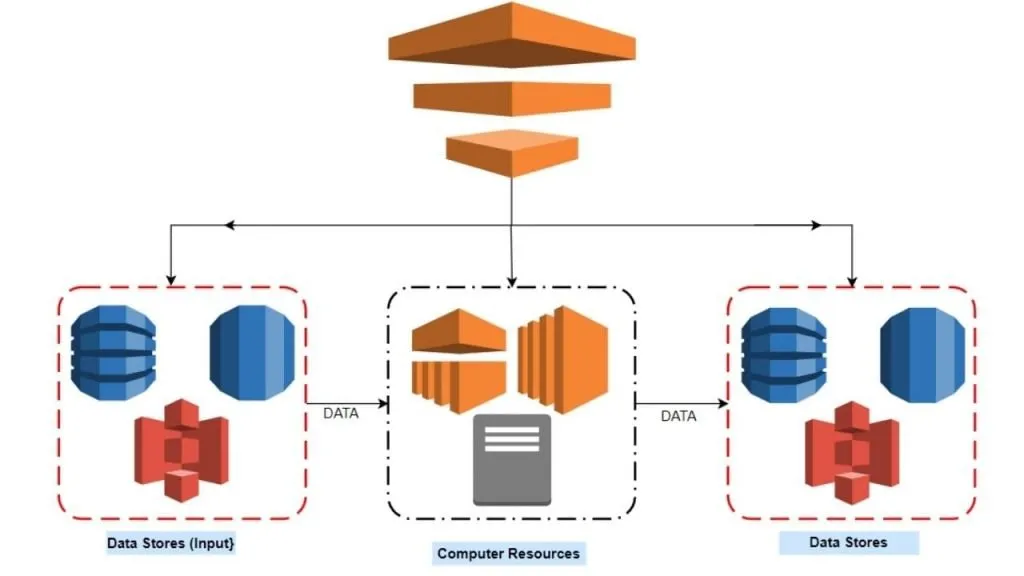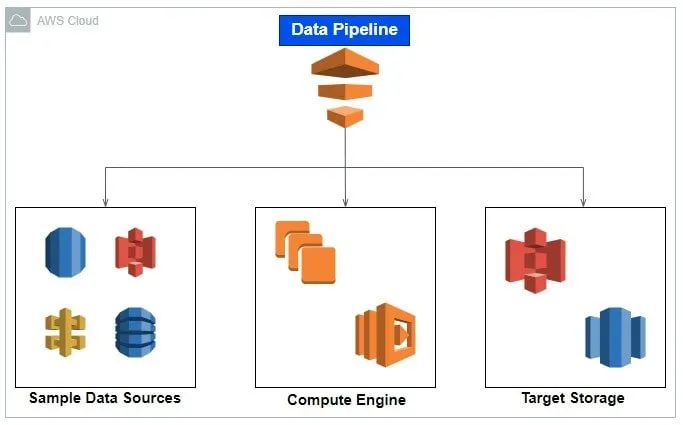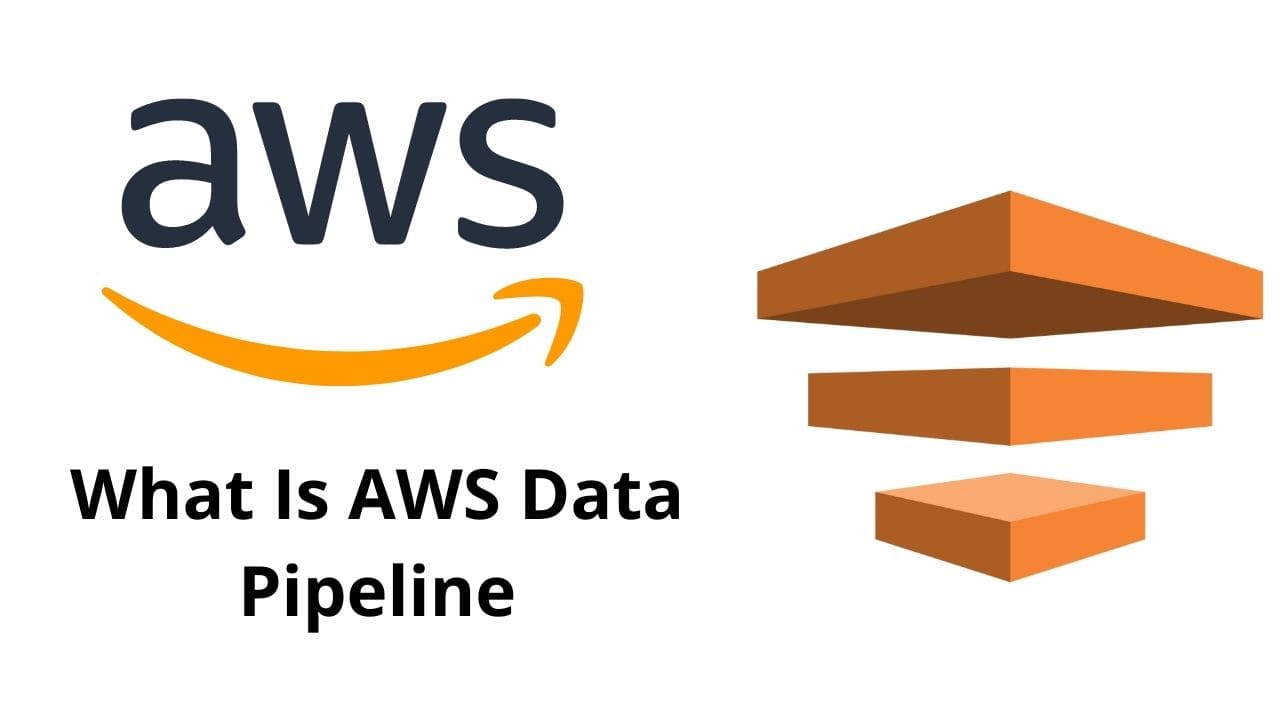What Is AWS Data Pipeline? Did you know about Amazon Web Services managed ETL service AWS Data Pipeline? If you don’t, read this article to get a comprehensive rundown of this service.
Less than two decades ago, the world of digital data storage used to be vastly different. You had to hire expensive teams and servers to store your business data.
It was expensive, tedious, and ineffective. However, in the present day, all of this can be confidently performed thanks to services like AWS Data Pipeline.
What Is AWS Data Pipeline? An Explanation
To those who are uninitiated, AWS Data Pipeline is a web service offered by Amazon Web services.
It allows you to manage, process, sort, refine, and transfer data between AWS services. This service performs reliably, protects your data, and helps you process an absurd amount of data in no time.

What core function does AWS Data Pipeline Perform?
We can quickly produce and retrieve data from wherever it is stored, convert it, process it at scale, and effectively transport the output to other AWS services using AWS Data Pipeline.
What is Data Pipeline?
The data pipeline is the management source of your business’ data; it handles everything to do with data storage. It is also known as a data creator who can locate and provide the data to the data consumer when called upon.
Why Was Data Pipeline Created?
To explain why the data pipeline was created, we have to use a laymen’s example. In this example, data equals water, and data pipeline equals its stored resources.
In simpler times, there was only a limited requirement for water hence, water was obtained directly from its resources like rivers, wells, etc.
However, as the water demand increased, a centralized system was introduced, so the water was brought to you, and you didn’t have to get it.
Data and data pipelines have a similar relation as when there was fewer data. It was managed manually, but a data pipeline service was created when it became too large to manage, sort, and refine.
Benefits of Using AWS Data Pipeline
Now that you are aware of the data pipeline, its history, and its specific version offered by Amazon web services as AWS Data Pipeline, we would like to focus on why people prefer to use it.
What are the core benefits consumers stand to gain from it? The following are the most significant benefits:
1. AWS Data Pipeline is A Very Dependable Service
Data pipeline on its own is a very dependable concept; hence, it was created in the first place. However, the AWS Data pipeline takes this to another level.
It offers you the ability to store, refine, sort, and move your business data, among other functions, to various AWS services seamlessly.
2. It is Very Convenient To Use
The second benefit AWS Data Pipeline provides its users is convenience.
Anyone with even the basic training in AWS services can use this service effortlessly; thus, this service makes their life stress free and convenient when it comes to managing their business data.
3. AWS Data Pipeline Service is Adjustable According To Your Business Needs
- Amazon web services data pipeline services serve you with another benefit in the form of flexibility.
- It allows you to utilize a host of features to manage, track, and move your data while simultaneously finding errors in it and correcting them before you even know it.
- This means you can schedule this AWS service to perform its task of managing your data and transferring it between various other AWS services without you worrying about any restrictions.
4. You Can Scale Your Work Up & Down Without Any Hindrance
- Scalability is another factor why AWS Data Pipeline has an impressive reputation for itself in such a brief period.
- This service allows you to scale up or down your business requirements without any hindrance.
- It can process millions of files as simple as processing a single file using the flexible architecture of AWS Data Pipeline.
5. Light on Your Pocket Service
We believe the most significant benefit AWS Data pipeline service possesses is the affordability, as you can use it for free using AWS free tier account.
Even if you choose to use its premium services, AWS Data Pipeline is a service that is light on your pocket.
Drawbacks of AWS Data Pipeline
AWS Data Pipeline is one of the top tier data pipeline services; however, we still believe it isn’t perfect. Thus, below we have mentioned the various drawbacks it has:
1. Integration With Third-Party Apps is Not Supported
AWS Data Pipeline, on its own, is a competent service that provides you with the conveniences you deserve.
Still, its usability when integrating with a third-party app is negligible. Therefore, you can only use it for the data it manages, and you cannot work by bringing data from other apps.
2. AWS Data Pipeline is An Complex Service For A Beginner
If you do not have a background in using other AWS services, directly using the AWS Data pipeline could be challenging.
This is because this service has a lot of modules that you need to learn beforehand, and it is considered a complex service for a beginner.
3. Other Easy Use Services Exist
The final drawback, according to us, AWS Data Pipeline possess is that due to its above-stated two limitations, this app is considered not the complete data pipeline app.
Other apps that perform similar tasks exist, and because they are easier to use and handle, they are considered better options.
Businesses For Whom AWS Data Pipeline is Ideal
Moving on from the benefits and drawbacks of AWS Data Pipeline, we now want to focus on for whom this service is ideal.
Therefore, without any further ado, we believe the following industries stand to utilize this service the best for their business: AWS Data Pipeline example.
● Stock Trading
Stock trading is a business where you need live data at every moment to function accurately. Hence, you need the service of a real-time data pipeline that AWS Data Pipeline service provides you.
● Cryptocurrency
Cryptocurrency is a business that needs a batch data pipeline and real-time data to make concerned and correct decisions. Only a reliable service like AWS Data Pipeline can provide this for your business.
● Fantasy Sports League
Like Stock Trading, Fantasy Sports League also relies heavily on a real-time data pipeline, but it also needs elements of a batch data pipeline for broader predictions. Hence, AWS Data Pipeline is ideal for them too.
● Online Dating
AWS Data Pipeline is ideal for online dating applications because it utilizes Lambda architecture which this service can provide.
● Social Media Platforms
Social media needs to process a copious amount of data, and for that, they need reliability and speed. AWS Data Pipeline is equipped enough to provide them with this; therefore is the perfect service for them to use.
In how many regions is AWS Data Pipeline service available?
AWS Data Pipeline is available in five regions with them being the following
| Oregon |
| Ireland |
| Sydney |
| Tokyo |
| Virginia |
Major perks of using AWS Data Pipeline?
The following are the perks of AWS Data Pipeline
| Perks of Using AWS Data Pipeline |
| Your data is reliably managed |
| You use a fantastic service at no to low prices |
| Allows you to scale your work |
Pros & Cons of AWS Data Pipeline
The Following are the pros & cons of the AWS Data Pipeline
| Pros | Cons |
|---|---|
| Reliable service | Does not support Third-Party data |
| Cost-effective | Complex service if you don’t know AWS services |
| Flexible | Other better services exist |
AWS Data Pipeline vs glue
Let’s try to find out the difference between the two most powerful services provided by AWS.
| Data Pipeline | Glue |
| The capacity to do ETL load integrates seamlessly with many AWS services like RDS, S3, and much more work like long-running jobs. | IGlue also has the capacity and power same as that of Data Pipeline. |
| The difference is this service is not serverless so infra management has to be taken care of by the team. | This being a serverless service the backend is managed automatically by AWS. |
| If you don’t need a service like spark this is a better choice as jobs can be executed in pig as well. API and JSON are used for transforming the data. | This supports the apache spark framework rest of the things like data transformation are the same as that of the Data Pipeline. |
| For Data pipeline you have to provision the AWS resources as this is not serverless so along with that we also have to pay for usage. | This being a serverless service we pay for what we use like ETL, Data Brew, Data Catalog, and Schema Registry. |
AWS Data Pipeline vs airflow
Let’s jot down the differences between services from AWS and Apache.
| Data Pipeline | Airflow |
| Helps to Extract Transform and Load the data between different AWS services. | Platform to create, schedule and monitor data loading pipelines. |
| Here we have the templates availed by AWS for using it on the fly. | Here we code the pipelines using python. |
| We can set up only using services from AWS, we cannot use external libraries. | The flexibility of using the libraries and extensions of your choice. |
| Can be used to do S3 data analysis and also sync data from DynamoDB to S3. | Resources can be parametrized and we have the flexibility of using an external engine as a template called Jinga. |
AWS data pipeline architecture
The architecture of a Data pipeline is the process of getting, transforming, and moving the data to various different services so that values can be derived from the raw data.
Let’s check out one example of such a data pipeline.

AWS Data Pipeline vs dataSync
| Data Pipeline | DataSync |
| Mainly used for data processing and distribution of data across AWS Services. | Naibly used to sync data continuously between two databases. |
| Loads data from S3, RDS, and Dynamo DB to other services after cleansing the data. | A fantastic tool to sync data between on-premises DB like Oracle etc to Cloud RDS like Oracle. |
AWS Data Pipeline Use cases
The use cases of a Data Pipeline are vast. Let us try to find a few of them.
- It can be used as an ETL tool to load data across systems.
- It is a very good tool for data flow orchestration. Suppose we have a process running then what steps to take on success and what steps to execute if the pipeline fails?
- Also can be used to load data between on-premises servers to cloud database instances.
- Helps to create pipelines that can be scheduled and can also be fault tolerant.
AWS Data Pipeline S3 to Dynamodb
AWS data pipeline incremental load
This is the feature of the Data Pipeline that is used to load incremental data from one database to another. The database can be on-premises or in the cloud, it supports both.
AWS data pipeline vs kinesis
| Data Pipeline | Kinesis |
| This is used for repetitive tasks, that can be scheduled to run multiple times a day. | This tool is used for high-speed data transfers for real-time or near-real-time data. |
| This is for orchestrating the data flow between AWS services. | This is used when we have hundreds of sources pushing data to AWS. |
FAQs of What Is AWS Data Pipeline
The following are the most FAQs of What Is AWS Data Pipeline.
Q: What Is The Primary Job Of AWS Data Pipeline?
AWS Data Pipeline allows you to manage, process, sort, refine and transfer data between AWS services.
This service performs reliably, protects your data, and helps you process an absurd amount of data in no time.
Q: Is AWS Data Pipeline Service Free?
Yes, AWS Data Pipeline services are free when you use it using with your free tier Amazon web services account.
Like many other AWS services, it has to pay as you use policy meaning you only have to pay for certain services when you have exhausted your free limit.
Q: How Much Bill Can I Expect If I Use AWS Data Pipeline Service?
You do not expect to pay a lot compared to other data pipeline services as this is a low-cost service.
However, if you wish to know the exact, then it depends on your usage, and for accurate AWS Data Pipeline pricing, visit this link – https://aws.amazon.com/datapipeline/pricing/
Q: The Number Of Pipelines I Can Establish From My AWS Data Pipeline Account?
You can establish up to one hundred pipelines from your AWS Data Pipeline account.
Q: How To Increase the Limit Of The AWS Data Pipeline Service?
The only way to increase AWS Data Pipeline service limits is by contacting an Amazon Web Services representative.
Q: Is Tax Included In My AWS Data Pipeline Bill?
Yes, tax is included in your AWS Data Pipeline bill.
However, according to the local government tax laws, you could be charged an additional tax for some regions.
Q: AWS data pipeline documentation?
We tried our best to summarize to the best of our knowledge, still for more details about this topic you can visit the AWS official site here.
Bottom Line
AWS Data Pipeline is one of the best data pipeline services in the world. It is used to manage and transport your data seamlessly between other AWS services.
Hence, in the AWS Data Pipeline tutorial, we have explained What Is AWS Data Pipeline, why AWS Data Pipeline is used, AWS Data Pipeline benefits, drawbacks, the business that uses them, and many more.
Go through this article to learn comprehensive knowledge of the subject and let us know how you find it to be in the comments section.
You may also like to explore below AWS blogs.
- What Is AWS EventBridge
- AWS Server Migration Service
- AWS DAX (Amazon DynamoDB Accelerator)
- AWS Disaster Recovery
Happy Clouding!

I am an Amazon Web Services Professional, having more than 11 years of experience in AWS and other technologies. Extensively working in various AWS tools like S3, Lambda, API, Kinesis, Load Balancers, EKS, ECS, and many more. Working as a Solution Architect and Technology Lead for Architecting and implementing the same for different clients. He provides expert solutions around the world and especially in countries like the United States, Canada, United Kingdom, Australia, New Zealand, etc. Check out the complete profile on About us.


